PMC/PubMed Indexed Articles
Indexed In
- Open J Gate
- Genamics JournalSeek
- JournalTOCs
- Ulrich's Periodicals Directory
- RefSeek
- Hamdard University
- EBSCO A-Z
- OCLC- WorldCat
- Publons
- Geneva Foundation for Medical Education and Research
- Euro Pub
- Google Scholar
Useful Links
Share This Page
Journal Flyer

Open Access Journals
- Agri and Aquaculture
- Biochemistry
- Bioinformatics & Systems Biology
- Business & Management
- Chemistry
- Clinical Sciences
- Engineering
- Food & Nutrition
- General Science
- Genetics & Molecular Biology
- Immunology & Microbiology
- Medical Sciences
- Neuroscience & Psychology
- Nursing & Health Care
- Pharmaceutical Sciences
Case Report - (2020) Volume 11, Issue 5
Dermatofibrosarcoma Protuberance of Male Breast: A Rare Case Presentation
Sharda P1, Chaitanya S1*, Kapoor A1, Sharma K2, Syed A1 and Ravi B12Department of Pathology, AIIMS Rishikesh Institute, Uttarakhand, India
Received: 13-Oct-2020 Published: 03-Nov-2020, DOI: 10.35248/2157-2518.20.11.356
Abstract
We report a case of a 50-year-old man who is a chronic smoker, referred to our IBCC (Integrated Breast Care Centre) department, in AIIMS, Rishikesh with complaints of a lump in his left breast for 6 years. A 3×2 cm, ill-defined, firm to hard, non-mobile lump located in the upper and outer quadrant of the left breast which is beneath the previous surgical scar with skin infiltration is noted. Histological characteristics of DFSP are the arrangement of monomorphic spindle cells in a storiform pattern. It was staged as T4b N0 M0 and left wide local excisional biopsy of the tumor with a macroscopically free margin of 3 cm and sent for frozen section which revealed a dendritic differentiation with free margins and further confirmed on final histopathological examination. The postoperative recovery of the patient was uneventful. No loco-regional recurrence or distant metastasis was noted for 6 months of regular follow-up.
Keywords
Breast cancer; Dermatofibrosarcoma; Lump
Introduction
TIn the literature, Taylor first described Dermatofibrosarcoma protuberans (DFSP) as a keloid sarcoma in 1890 [1]. “Ferrand later identified it as a recurrent dermatofibroma” [2]. It is a rare soft tissue sarcoma accounting <5% out of all soft tissue tumors identified in early or middle age [3]. Most commonly seen in 20-50 year age groups but rarely reported in young and elderly people. The term ''Dermatofibrosarcoma protuberance'' (DFSP) was coined by Hoffman et al in the year 1925, after modifying the previous existing term dermatofibroma [3]. DFSP is an intermediate grade mesenchymal tumor of fibroblastic origin arising from dermis involving subcutaneous tissue and musculature [4]. The majority of this tumor is observed in the trunk region (47.4%) and extremities (38.1%) [5]. Breast involvement of DFSP is a rare entity and even rarer in men. In literature, Some case reports of breast involvement in females are noted, but the involvement of the breast in the male are extremely rare. If involved, they present clinically as erythematous indurated firm subcutaneous nodules in the breast region [4].
On clinical examination, small nodule noted on the skin surface, which is firm and irregular inconsistency, varying from flesh to reddish-brown. "Platelet-derived Growth factor (PDGF) increase response leads to increased formation of tumor cells by reciprocal translocations of chromosomes 17 and 22, t (17;22), and supernumerary ring chromosomes composed of interspersed sequences from bands 17 (17q22) and 22 (22q12)" [6,7]. Histological characteristics of DFSP are the arrangement of monomorphic spindle cells in a storiform pattern. Distant metastasis is noted but the incidence is rare. Treatment is primarily surgical excision with wide margins, with or without adjuvant chemotherapy and radiation. In this article, we report a rare case presentation of a 50 year old male patient with Dermatofibrosarcoma Protuberance tumor in his left breast.
Case Presentation
We report a case of a 50-year-old man who is a chronic smoker, referred to our IBCC (Integrated Breast Care Centre) department, in AIIMS, Rishikesh with complaints of a lump in his left breast for 6 years. The history revealed similar left breast lump 14 years back for which excision was done in a private hospital. The pre and post-operative details of the patient condition at that time are not available. Later on, he developed breast soreness at the operative site 6 years back which progressively increased in size. No family history significant of breast cancer. This patient is considered for further examination.
Clinical examination
A 3 × 2 cm, ill-defined, firm to hard, non-mobile lump located in the upper and outer quadrant of the left breast which is beneath the previous surgical scar with skin infiltration is noted. There is a healed scar noted in the upper/outer quadrant of the left breast (Figure 1). No axillary lymph nodes are palpable on examination. Opposite breast and axillary examination findings are insignificant. Then the patient is subjected to further radiological evaluation (Figure 1).
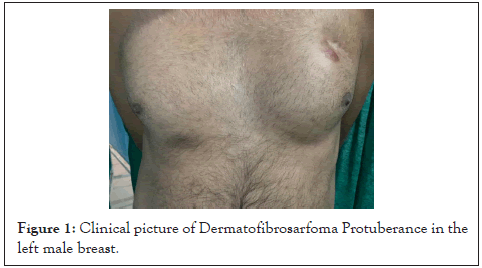
Figure 1: Clinical picture of Dermatofibrosarfoma Protuberance in the left male breast.
Imaging
On ultrasonogram, it was revealed that a relatively well defined 2.5 × 2.3 cm, wider than taller oval-shaped hetero-echoic lesion noted at 11-12 o clock position which is 0.2 cm deep to the skin, 4 cm away from the nipple and noted beneath the scar mark and mammography, demonstrated a well-defined, 2.8 × 2.5 cm, round to oval, a high-density lesion in the upper central region of left breast, within 2 cm from the nipple, with mild architectural distortion noted in the vicinity of the lesion which is categorized as BI-RADS (Breast Imaging Reporting and Data System) 4B lesion with moderate suspicion of malignancy (10%-50%) (Figures 2 and 3).
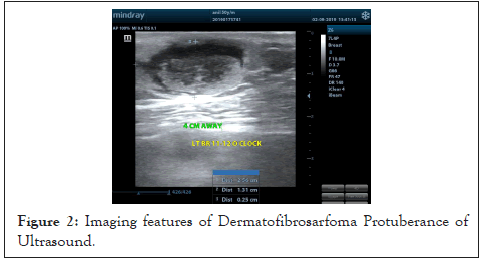
Figure 2: Imaging features of Dermatofibrosarfoma Protuberance of Ultrasound.
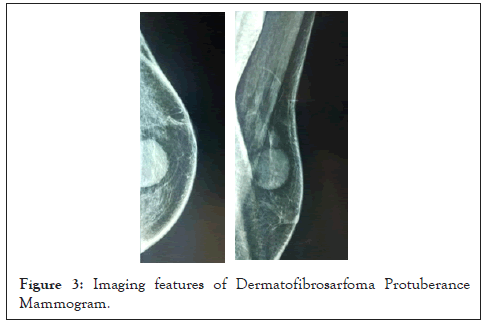
Figure 3: Imaging features of Dermatofibrosarfoma Protuberance Mammogram.
Ultrasound grayscale image shows a well-defined, oval, heteroechoic lesion, free from underlying muscles and overlying skin. Overlying skin is thickened.
(i) Craniocaudal and (ii) mediolateral oblique view of left breast shows a well-defined, round to oval high-density lesion in the upper central quadrant, with mild surrounding architectural distortion. Diffuse skin thickening noted. No calcification noted within the lesion.
Pathological examination
The patient had a Fine needle aspiration (FNAC) of the lesion which revealed as singly cellular exhibiting tumor cell fragments of irregular plump ovoid to spindle cells scanty eosinophilic cytoplasm and bland nuclear chromatin with prominent nucleoli. Tumor cell fragments are elongated with collagenous fibrous stroma which is suggestive of spindle cell sarcoma, malignant phyllodes, and metastatic carcinoma. On Core needle biopsy, it revealed as uniform spindle cells arranged in fascicles and exhibiting prominent storiform pattern with an area of tumor-infiltrating fat also seen which are in favor of dermatofibrosarcoma protuberance (Figure 4). On Immunohistochemistry CD 34 is positive and all other markers are negative such as CK, DESMIN, S-100, SMA, P63, ER, Bcl2, CD99, TLE-1, STAT6, EMA (Figure 5).
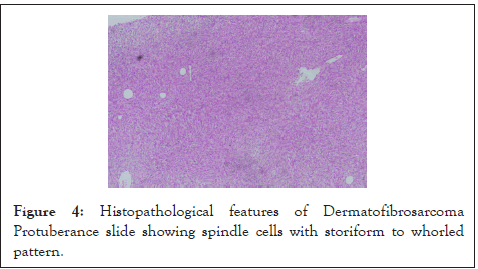
Figure 4: Histopathological features of Dermatofibrosarcoma Protuberance slide showing spindle cells with storiform to whorled pattern.
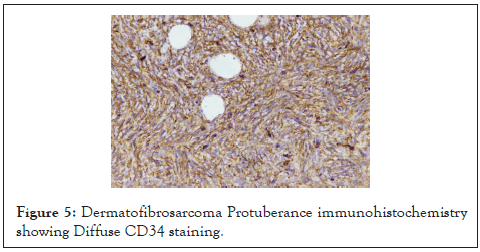
Figure 5: Dermatofibrosarcoma Protuberance immunohistochemistry showing Diffuse CD34 staining.
Metastatic Workup
Chest X-ray and ultrasound of the abdomen were performed, which are normal in the study and we further proceeded for CECT (Thorax and Abdomen) in which there was no evidence of distant metastases.
Management
Provisional diagnosis as Dermatofibrosarcoma protuberance involving left breast is confirmed and was staged as T4b N0 M0. We performed left wide local excisional biopsy of the tumor with a macroscopically free margin of 3 cm and sent for frozen section which revealed a dendritic differentiation with free margins. The postoperative recovery of the patient was uneventful. On the final histological examination, the surgical margins were 3 cm which is free from the tumor, and the diagnosis of DFSP of the left breast was confirmed. No loco-regional recurrence or distant metastasis was noted for 6 months of regular follow-up.
Results and Discussion
Dermatofibrosarcoma protuberans (DFSP) is a soft tissue tumor of low grade involving the dermis and further extends into subcutaneous tissues, underlying musculature [8]. It accounts for about <0.1% of all malignant neoplasms and approximately 1% of all soft tissue sarcomas. It was previously considered that DFSP does not present in any specific ethnic, community or geographic areas, but after analyzing cases by Criscione and Weinstock from the year 1973 to 2002, it was found that the annual incidence of DFSP in the United States is 4.2 per million/yr, and was predominant in black males with a DFSP pigmentary variant (Bednar tumor) [9,10].
The average age of presentation is 38.5 years with equally distributed in both genders [11]. In a study conducted by Rutgers et al., out of total sample size 514 patients, 57% were males [12]. A recent case report by Cavusoglu and colleagues reported tumor presentation and breast involvement are even rare in females [13]. The most common site of this tumor presentation are trunk and extremities and breast involvement is even rare [14]. A study by Karcnik et al. reported less involvement of the breast region [15]. We reviewed the literature regarding this tumor case report and found only 11 cases of DFSP involving breast in male patients in PubMed and Google Scholar from 1994 to 2019 [16-24]. The mean age of these patients was 33.6 years ranging from 9 to 55 years, in our case report, the age of presentation is 50 years and the mean tumor size is 6.2 cm ranging from 3-13 cm similar to our case which has max diameter size of 2.5 cm.
The ethio-pathogenesis of DFSP remains unclear and mainly observed to be associated with post-traumatic areas like tattoos, burn scars, vaccination sites, surgical scars, and radiotherapy [22]. Trauma may initiate a chronic inflammatory process that leads to disorder in the immune system and then malignant transformation of the dermal component is noted [22]. “This hypothesis is supported by genetic findings such as chromosomal translocation of t (17; 22) (q22; q13) between chromosomes 17 and 22, the fusion of gene COL6A3-PDGFD, and the fusion of gene COL1A1- PDGFB” [23,24].
The most common presentation of DFSP in the male breast is an irregular mass with extensive nodules over the surface, with size measuring 1-5 cm in diameter [16-24]. This presentation could imitate various other conditions like carcinoma, phyllodes tumor, and myoepithelioma [22]. In our case, the clinical appearance was the appearance of a small lump at a previously operated site which progressively increased in size. In mammography, it appears as an irregular dense mass without fat or calcification [25]. Ultrasound shows a heterogeneous or hypoechoic mass, irregular with hypervascularity of the affected areas in color Doppler [22].
Due to these nonspecific imaging findings, pathological assessment is required for confirming the diagnosis [4]. Histological characteristics of DFSP are the arrangement of monomorphic spindle cells in a storiform pattern (Figure 4). The intense staining for CD34 differentiates DFSP from myxoid liposarcoma [4,16,17]. Our case showed diffuse strong positivity for CD34 and negative for all other markers like CK, DESMIN, S-100, SMA, P63, ER, Bcl2, CD99, TLE-1, STAT6, EMA (Figure 5).
Surgical excision of the tumor remains the cornerstone for managing these tumors considering oncological outcomes and cosmetic issues related to male breasts. Wide Local Excision technique with or without plastic reconstruction as the preferred surgery in DFSP [19]. The resection margins of at least 2-3 cm are recommended for treatment because of local recurrence rate is 20% to 50% [4]. In a pooled analysis of published series of DFSP treated with MMS or WLE, the local recurrence rate averages about 1.5% [26-31].
Adjuvant therapy like chemotherapy or radiation to the tumor bed is needed for an unresectable lesion or resected lesion with positive surgical margins which will decrease the rate of local recurrence and prevent the mutilation, functional deficits resulting from repeated surgeries [26]. “Imatinib used as an immunotherapy agent for unresectable, recurrent, and metastatic DFSP who are not eligible for surgical excision showed a response rate between 5.2% and 55.2%” [27]. Although distant metastasis rates of DFSP are rare (1%-4%), but they are associated with high rates of local recurrence and mortality rate in 2 yrs. A small subset of patients presents with the variation of DFSP like fibrosarcomatous progression which will have more aggressive features and associated with poor prognosis [31]. Poor prognostic factors associated with DFSP are elderly age groups, a high mitotic index, and increased cellularity [28].
Long-term follow-up is required in these tumors due to high recurrence rates.
Conclusion
Our case has been treated with wide local excision with a 3 cm margin status with negative margins on the frozen section and confirmed by histopathology followed by no adjuvant treatment.
REFERENCES
- Taylor RW. Sarcomatous tumors resembling in some respect keloids. J Cutan Genitourin Disord. 1890;8 (4):384.
- Ferrand M. Dermatofibrosarcomas progressive and recurrent or fibrosarcoma of the few. Ann Dermatol Syphiligr.1924;5 (3):545-562.
- Hoffman E. Over the knoll driving fibrosarcoma of the skin (Dermatofibrosarcoma protuberans). Dermatol Ztschr.1925;43 (5):1-28.
- Tarakji M, Toro A, Carlo I, Junejo K. Unusual presentation of dermatofibrosarcoma protuberans in a male patient’s breast: a case report and review of the literature. World J Surg Oncol. 2015;13 (4):158.
- Weiss SW, Goldblum JR. Enzinger and Weiss’s Soft Tissue Tumors (5th edn), Elsevier Publishers, USA, 2008.Pp:371-385.
- Simon MP, Pedeutour F, Sirvent N, Grosgeorge J, Minoletti F, Coindre JM, et al. Deregulation of the platelet-derived growth factor B-chain gene via fusion with collagen gene COL1A1 in dermatofibrosarcoma protuberans and giant-cell fibroblastoma. Nat Genet. 1997;15 (1):95-98.
- Maki RG, Awan RA, Dixon RH, Jhanwar S, Antonescu CR. Differential sensitivity to imatinib of 2 patients with metastatic sarcoma arising from dermatofibrosarcoma protuberans. Int J Cancer. 2002;100 (6):623-626.
- Kransdorf MJ, Meis-Kindblom JM. Dermatofibrosarcoma protuberans: radiologic appearance. AJR Am J Roentgenol. 1994 (2);163:391-394.
- Criscione VD, Weinstock MA. Descriptive epidemiology of dermatofibrosarcoma protuberans in the United States, 1973 to 2002. J Am Acad Dermatol. 2007;56 (6):968-973.
- Karcnik TJ, Miller JA, Fromowitz F, Abujudeh H, Hertz MB. Dermatofibrosarcoma protuberans of the breast: A rare malignant tumor simulating benign disease. Breast J. 1999;5 (4):262-263.
- Boukovalas S, Castillo AC, Andry D. Dermatofibrosarcoma protuberans: trauma and genetics. Ann Plast Reconstr Surg. 2017 ();1:1001.
- Rutgers EJ, Kroon BB, Albus-Lutter CE, Gortzak E. Dermatofibrosarcoma protuberans: treatment and prognosis. Eur J Surg Oncol. 1992;18 (3):241-248.
- Cavuşoğlu T, Yavuzer R, Tuncer S. Dermatofibrosarcoma protuberans of the breast. Aesthetic Plast Surg. 2003;27 (2):104-106.
- Barwani AS, Taif S, Al Mazrouai RA, Al Muzahmi KS, Alrawi A. Dermatofibrosarcoma protuberans: Insights into a rare soft tissue tumor. J Clin Imaging Sci. 2016;6 (4):16.
- Karcnik TJ, Miller JA, Fromowitz F, Abujudeh H, Hertz MB. Dermatofibrosarcoma protuberans of the breast: A rare malignant tumor simulating benign disease. Breast J. 1999;5 (4):262-263.
- Chen X, Chen YH, Zhang YL, Guo YM, Bai ZL, Zhao X. Magnetic resonance imaging and mammographic appearance of dermatofibrosarcoma protuberans in a male breast: a case report and literature review. J Med Case Rep. 2009;3 (6):8246.
- Park JY, Jang YH, Kim YC. Subcutaneous dermatofibrosarcoma protuberans on the breast. Korean J Dermatol. 2011; 49 (11):1025-1027.
- Akhtar K, Sherwani RK, Ray PS. Dermatofibrosarcoma protuberans of the male breast: An unusual presentation. Oman Med J. 2012;27 (4):38.
- Prabhu VV, Shivani A, Kulkarni SH, Pawar VR. Dermatofibrosarcoma protuberans: male breast. Med J DY Patil Univ. 2014;7 (1):85-87.
- Saikia BK, Das I, Mandal GK. Fibrosarcomatous change in the background of dermatofibrosarcoma protuberans in the male breast: a study of a rare case and review of the entity. J Midlife Health. 2016;7 (1):45-48.
- Ezejiofor IF, Onwukamuche ME, Anyiam DCD, Ugwu JO, Ndukwe CO, Madubuike Kc, et al. Breast dermatofibrosarcoma protuberans in an adolescent male: a case report and extensive review of the literature. Trop J Med Res. 2017;20 (8):204-207.
- Diwakar DK, Wadhwani N, Paruthi S. Recurrent dermatofibrosarcoma protuberans: Challenging a surgeon’s dexterity for the “tricky” margins. Ecancer Medical Sci. 2018;12 (8):858.
- Dhakal R, Makaju R, Makaju S, Shrestha G. Dermatofibrosarcoma protuberans of the male breast: A case report. Int Clin Pathol J. 2018;6 (4):154-156.
- Murase Y, Takeichi T, Matsumoto T, Sakakibara A, Akiyama M. A juvenile male case of dermatofibrosarcoma protuberans on the breast. Clin Exp Dermatol. 2019;45 (1):111-113.
- Lee SJ, Mahoney MC, Shaughnessy E. Dermatofibrosarcoma protuberans of the breast: imaging features and review of the literature. AJR Am J Roentgenol. 2009;193 (1):64-69.
- Sun LM, Wang CJ, Huang CC, Leung SW, Chen HC, Fang FM, et al. Dermatofibrosarcoma protuberans: Treatment results of 35 cases. Radiother Oncol. 2000;57 (2):175-181.
- Navarrete-Dechent C, Mori S, Barker CA, Dickson MA, Nehal KS. Imatinib treatment for locally advanced or metastatic dermatofibrosarcoma protuberans: A systematic review. JAMA Dermatol. 2019;155 (1):361-369.
- Bowne WB, Antonescu CR, Leung DH, Katz SC, Hawkins WG, Woodruff JM, et al. Dermatofibrosarcoma protuberans: a clinicopathologic analysis of patients treated and followed at a single institution. Cancer. 2000;88 (12):2711-2720.
- Dagan R, Morris CG, Zlotecki RA, Scarborough MT, Mendenhall WM. Radiotherapy in the treatment of dermatofibrosarcoma protuberans. Am J Clin Oncol. 2005;28 (6):537-539.
- Gloster HM Jr, Harris KR, Roenigk RK. A comparison between Mohs micrographic surgery and wide surgical excision for the treatment of dermatofibrosarcoma protuberans. J Am Acad Dermatol. 1996;35 (1):82-87
- Abbott JJ, Oliveira AM, Nascimento AG. The prognostic significance of fibrosarcomatous transformation in dermatofibrosarcoma protuberans. Am J Surg Pathol. 2006;30 (4):436-443.
Citation: Sharda P, Chaitanya S, Kapoor A, Sharma K, Syed A, Ravi B (2020) Dermatofibrosarcoma Protuberance of Male Breast: A Rare Case Presentation. J Carcinog Mutagen. 11:356
Copyright: © 2020 Sharda P, et al. This is an open-access article distributed under the terms of the Creative Commons Attribution License, which permits unrestricted use, distribution, and reproduction in any medium, provided the original author and source are credited.


